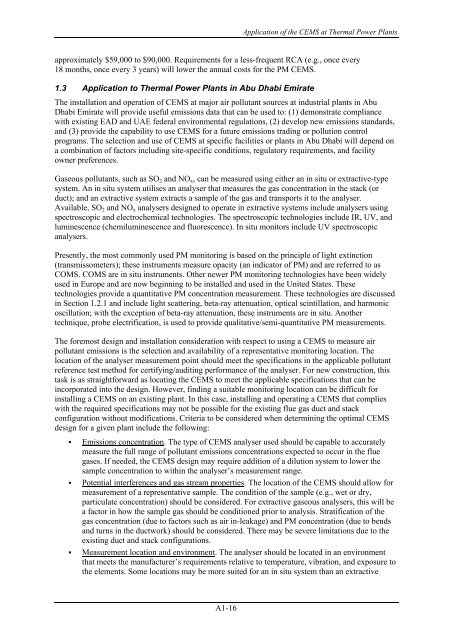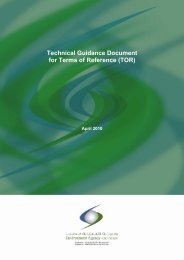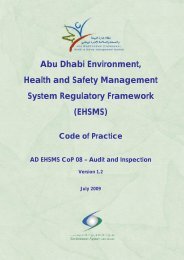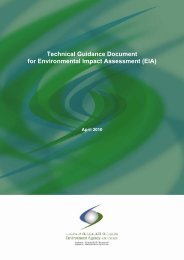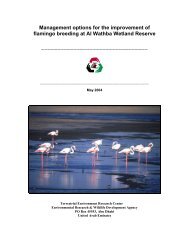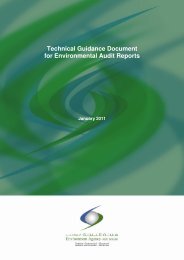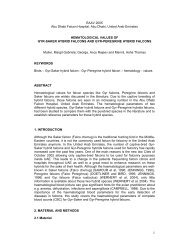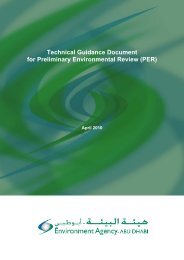Standard Operating Procedure (SOP) for Compliance Monitoring ...
Standard Operating Procedure (SOP) for Compliance Monitoring ...
Standard Operating Procedure (SOP) for Compliance Monitoring ...
You also want an ePaper? Increase the reach of your titles
YUMPU automatically turns print PDFs into web optimized ePapers that Google loves.
Application of the CEMS at Thermal Power Plants<br />
approximately $59,000 to $90,000. Requirements <strong>for</strong> a less-frequent RCA (e.g., once every<br />
18 months, once every 3 years) will lower the annual costs <strong>for</strong> the PM CEMS.<br />
1.3 Application to Thermal Power Plants in Abu Dhabi Emirate<br />
The installation and operation of CEMS at major air pollutant sources at industrial plants in Abu<br />
Dhabi Emirate will provide useful emissions data that can be used to: (1) demonstrate compliance<br />
with existing EAD and UAE federal environmental regulations, (2) develop new emissions standards,<br />
and (3) provide the capability to use CEMS <strong>for</strong> a future emissions trading or pollution control<br />
programs. The selection and use of CEMS at specific facilities or plants in Abu Dhabi will depend on<br />
a combination of factors including site-specific conditions, regulatory requirements, and facility<br />
owner preferences.<br />
Gaseous pollutants, such as SO 2 and NO x , can be measured using either an in situ or extractive-type<br />
system. An in situ system utilises an analyser that measures the gas concentration in the stack (or<br />
duct); and an extractive system extracts a sample of the gas and transports it to the analyser.<br />
Available, SO 2 and NO x analysers designed to operate in extractive systems include analysers using<br />
spectroscopic and electrochemical technologies. The spectroscopic technologies include IR, UV, and<br />
luminescence (chemiluminescence and fluorescence). In situ monitors include UV spectroscopic<br />
analysers.<br />
Presently, the most commonly used PM monitoring is based on the principle of light extinction<br />
(transmissometers); these instruments measure opacity (an indicator of PM) and are referred to as<br />
COMS. COMS are in situ instruments. Other newer PM monitoring technologies have been widely<br />
used in Europe and are now beginning to be installed and used in the United States. These<br />
technologies provide a quantitative PM concentration measurement. These technologies are discussed<br />
in Section 1.2.1 and include light scattering, beta-ray attenuation, optical scintillation, and harmonic<br />
oscillation; with the exception of beta-ray attenuation, these instruments are in situ. Another<br />
technique, probe electrification, is used to provide qualitative/semi-quantitative PM measurements.<br />
The <strong>for</strong>emost design and installation consideration with respect to using a CEMS to measure air<br />
pollutant emissions is the selection and availability of a representative monitoring location. The<br />
location of the analyser measurement point should meet the specifications in the applicable pollutant<br />
reference test method <strong>for</strong> certifying/auditing per<strong>for</strong>mance of the analyser. For new construction, this<br />
task is as straight<strong>for</strong>ward as locating the CEMS to meet the applicable specifications that can be<br />
incorporated into the design. However, finding a suitable monitoring location can be difficult <strong>for</strong><br />
installing a CEMS on an existing plant. In this case, installing and operating a CEMS that complies<br />
with the required specifications may not be possible <strong>for</strong> the existing flue gas duct and stack<br />
configuration without modifications. Criteria to be considered when determining the optimal CEMS<br />
design <strong>for</strong> a given plant include the following:<br />
• Emissions concentration. The type of CEMS analyser used should be capable to accurately<br />
measure the full range of pollutant emissions concentrations expected to occur in the flue<br />
gases. If needed, the CEMS design may require addition of a dilution system to lower the<br />
sample concentration to within the analyser’s measurement range.<br />
• Potential interferences and gas stream properties. The location of the CEMS should allow <strong>for</strong><br />
measurement of a representative sample. The condition of the sample (e.g., wet or dry,<br />
particulate concentration) should be considered. For extractive gaseous analysers, this will be<br />
a factor in how the sample gas should be conditioned prior to analysis. Stratification of the<br />
gas concentration (due to factors such as air in-leakage) and PM concentration (due to bends<br />
and turns in the ductwork) should be considered. There may be severe limitations due to the<br />
existing duct and stack configurations.<br />
• Measurement location and environment. The analyser should be located in an environment<br />
that meets the manufacturer’s requirements relative to temperature, vibration, and exposure to<br />
the elements. Some locations may be more suited <strong>for</strong> an in situ system than an extractive<br />
A1-16


